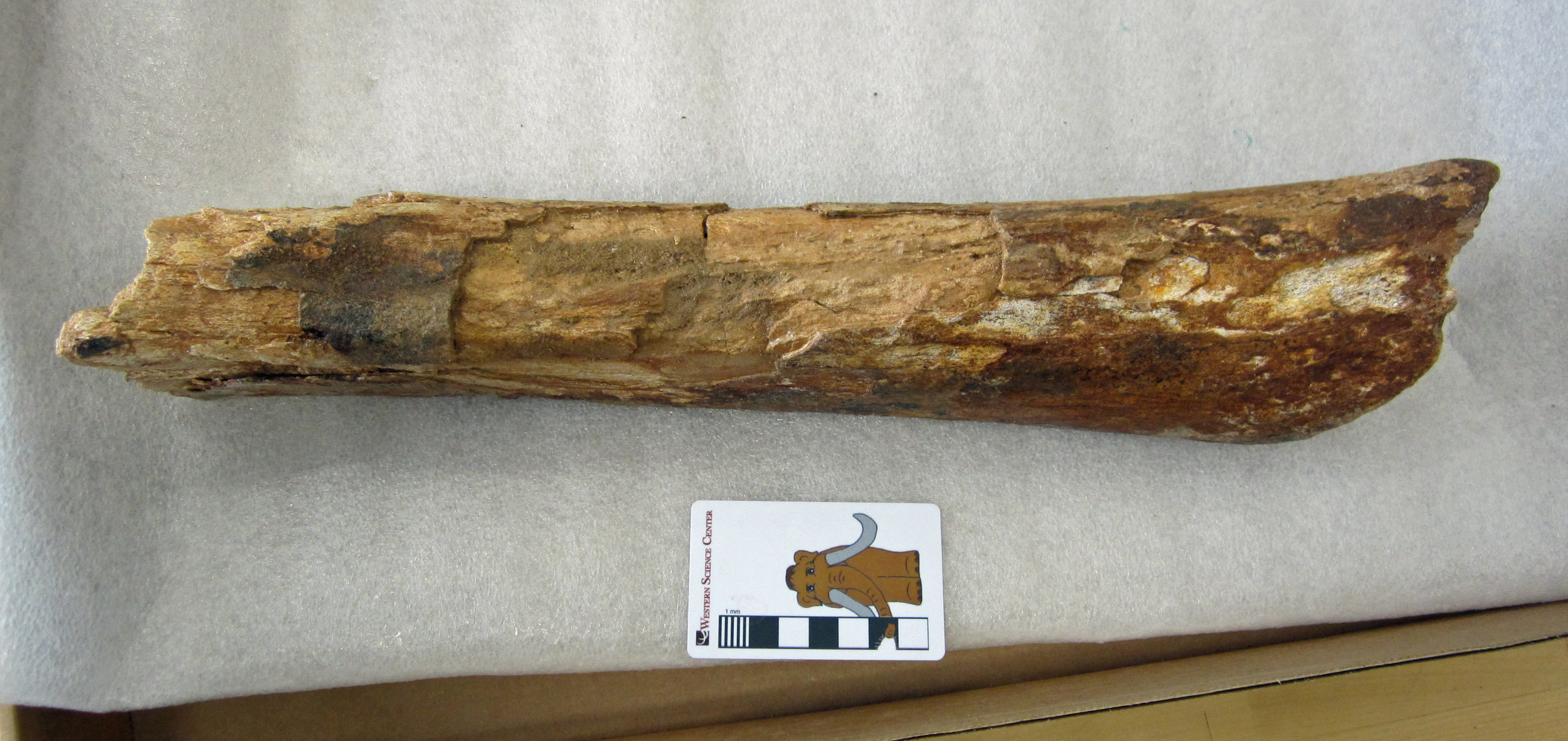 The Diamond Valley collection housed at WSC is an extremely rich record of Ice Age life in southern California, but it is far from the only Pleistocene site represented in the museum's collections.Right now, fossils of mammoths, camels, bison, horses, and other Ice Age megafauna from Joshua Tree National Park are on display in our "Fossils of Joshua Tree" exhibit. We are actively exploring new Pleistocene sites throughout Riverside County with colleagues from several institutions.In April, in conjunction with staff from the U.S. Bureau of Land Management, we collected this large incomplete mammalian limb bone from Pleistocene deposits near Blythe. It has recently been prepared in our lab, so now ahead is the task of comparing it to other large Ice Age mammal fossils and determining what kind of animal it is. It might belong to a large Ice Age camel such as Camelops hesternus, the species also found at Diamond Valley, La Brea Tar Pits, and many other sites in North America. We have much more discover in southern California's Pleistocene.Post by Curator Dr. Andrew McDonald.
The Diamond Valley collection housed at WSC is an extremely rich record of Ice Age life in southern California, but it is far from the only Pleistocene site represented in the museum's collections.Right now, fossils of mammoths, camels, bison, horses, and other Ice Age megafauna from Joshua Tree National Park are on display in our "Fossils of Joshua Tree" exhibit. We are actively exploring new Pleistocene sites throughout Riverside County with colleagues from several institutions.In April, in conjunction with staff from the U.S. Bureau of Land Management, we collected this large incomplete mammalian limb bone from Pleistocene deposits near Blythe. It has recently been prepared in our lab, so now ahead is the task of comparing it to other large Ice Age mammal fossils and determining what kind of animal it is. It might belong to a large Ice Age camel such as Camelops hesternus, the species also found at Diamond Valley, La Brea Tar Pits, and many other sites in North America. We have much more discover in southern California's Pleistocene.Post by Curator Dr. Andrew McDonald.
Gold Fever! comes to Western Science Center
 On Saturday we opened a new temporary exhibit, "Gold Fever! Untold stories of the California Gold Rush." The panels that make up the core of the exhibit were developed by the Oakland Museum of California and the California Council for the Humanities.The panels in the exhibit are supported by a selection of artifacts from the WSC archaeology collection, and additional specimens on loan from local residents and businesses:
On Saturday we opened a new temporary exhibit, "Gold Fever! Untold stories of the California Gold Rush." The panels that make up the core of the exhibit were developed by the Oakland Museum of California and the California Council for the Humanities.The panels in the exhibit are supported by a selection of artifacts from the WSC archaeology collection, and additional specimens on loan from local residents and businesses:
 One of my favorites is this rust-encrusted revolver:
One of my favorites is this rust-encrusted revolver:
 Having arrived in California so recently, this was a fun exhibit for me to explore, since it's essentially a primer on California history during the mid-1800s. The discovery of gold in California in 1848 set of a wave of immigration that had cascading effects, both good and bad. The region grew so abruptly that by 1850 California was granted statehood, barely two and a half years after gold was discovered here.Many of the artifacts on display are on loan from the Gilman Historic Ranch and Wagon Museum and from American Prospector Treasure Seeker, who also did a gold panning demonstration at our WSC members' reception on Friday night. We've also received support on this exhibit from Big 5 Sporting Goods in Hemet, who donated metal detectors, pans, and field equipment for a raffle. Raffle tickets can be purchased at the WSC box office, and winners will be drawn in January after the exhibit closes."Gold Fever!" will be open at WSC until January 15.
Having arrived in California so recently, this was a fun exhibit for me to explore, since it's essentially a primer on California history during the mid-1800s. The discovery of gold in California in 1848 set of a wave of immigration that had cascading effects, both good and bad. The region grew so abruptly that by 1850 California was granted statehood, barely two and a half years after gold was discovered here.Many of the artifacts on display are on loan from the Gilman Historic Ranch and Wagon Museum and from American Prospector Treasure Seeker, who also did a gold panning demonstration at our WSC members' reception on Friday night. We've also received support on this exhibit from Big 5 Sporting Goods in Hemet, who donated metal detectors, pans, and field equipment for a raffle. Raffle tickets can be purchased at the WSC box office, and winners will be drawn in January after the exhibit closes."Gold Fever!" will be open at WSC until January 15.



